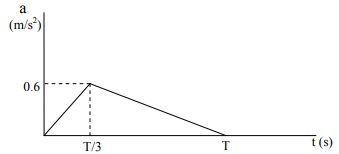Assignment:
Clearly define your coordinate system and its origin. If a question asks for a vector quantity, you must specify both magnitude and direction in your answer. Units must be consistent.
Q1) Suppose a person unwisely drives 75 mph (uniform speed) in a 55 mph zone and passes a police car going 55 mph in the same direction. If the police officer begins constant acceleration at the instant he is passed and increases his car's velocity to 80 mph in 4 seconds, how long does it take him to be even with the pursued car?
Q2) The position coordinate of a particle which is confined to move along a straight line (say, X-axis) is given by s = (-2+3t)e-0.5t, where s is measured in meters from a convenient origin and t is in seconds. Figure below depicts the s-t graph of the particle's motion.
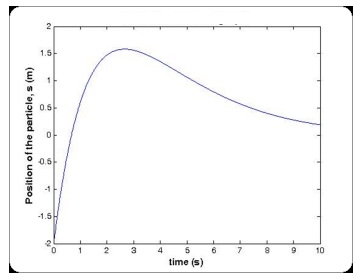
a) Compute the net displacement of the particle from t = 0.5 sec to t = 7.5 sec.
b) What are the average speed and the average velocity of the particle from t = 0 sec to t = 10 sec?
c) What is the instantaneous velocity of the particle at time t = 5 sec? What is the instantaneous speed of the particle at t = 5 sec?
d) What is the average acceleration of the particle from t = 0 sec to t = 10 sec?
e) What is the instantaneous acceleration of the particle at t = 7 sec?
Q3) A 200-gram ball is tossed straight up with an initial speed of 10 m/s from a window located 20 m above the ground. Determine
a) the velocity v and elevation y of the ball above the ground at any instant
b) the highest elevation reached by the ball and the time it took to reach that point
c) the time when the ball will hit the ground and the corresponding velocity
d) the acceleration of the ball when it is at the highest point and when it is just about to hit the ground
Q4) A projectile is launched from A with the initial conditions shown in the figure. Determine how far down the incline the projectile lands (i.e. find L). Also, calculate the total time of flight and the velocity with which the projectile impacts point B.
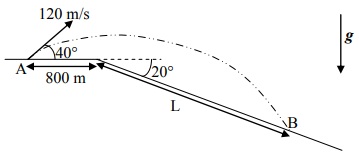
Q5) With what minimum horizontal velocity u should the boy throw a ball from point A so that it just clears the obstruction at B.? Assume the wind gives the ball an additional uniform acceleration in the direction shown.
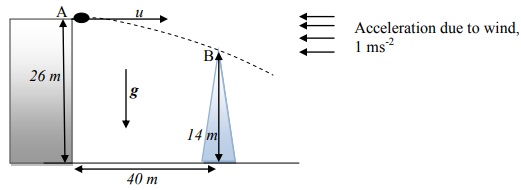
Q6) The aerodynamic resistance to motion of a car is nearly proportional to the square of its velocity. Additional friction resistance is constant, so that the acceleration of the car when coasting under braking may be written as a = -C1-C2v2 , where C1 = 2 m/s2, C2 = 0.004 m-1. If the car has an initial velocity v0 = 60 mph, when the engine is disengaged,
i) find the distance D required for the car to coast to a stop, and
ii) find the time it takes to come to a halt.
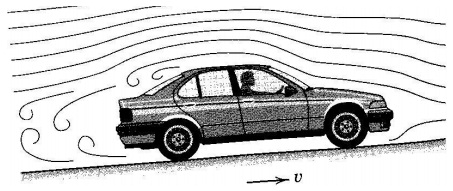
Q7) Jill shoots an arrow from the top of a tower with a speed of 10 m/s. The height of the tower is 50 meters.
a) At what angle should Jill launch her arrow to maximize her range of shot?
b) Compute this range (i.e. distance from the base of tower where the arrow lands).
Repeat a) and b) assuming Jill is standing on ground (i.e. at the base of the tower).
Q8) An elevator starts from rest and rises 40 m to its maximum velocity in T seconds with the acceleration record shown in the figure below. Determine a) the time T, b) the maximum velocity, c) the velocity and position of the elevator at t = T/2.
